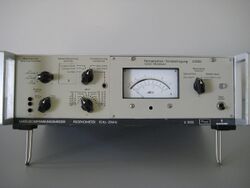Engineering:Psophometer
In telecommunications, a psophometer is an instrument that measures the perceptible noise of a telephone circuit.[1]
The core of the meter is based on a true RMS voltmeter, which measures the level of the noise signal. This was used for the first psophometers, in the 1930s.[2] As the human-perceived level of noise is more important for telephony than their raw voltage, a modern psophometer incorporates a weighting network to represent this perception.[1][2][3] The characteristics of the weighting network depend on the type of circuit under investigation, such as whether the circuit is used to normal speech standards (300 Hz – 3.3 kHz), or for high-fidelity broadcast-quality sound (50 Hz – 15 kHz).[1]
Etymology
The name was coined in the 1930s, on a basis from Ancient Greek:, itself derived from Ancient Greek:.[4] It is unrelated to Ancient Greek:.
The '-meter' suffix Ancient Greek: was already widely used in English, but also derives originally from Greek.[4]
See also
References
- ↑ 1.0 1.1 1.2 Ian Hickman (March 2001). "Balanced circuits". Electronics World: 190–191.
- ↑ 2.0 2.1 Harbottle, H.R. (August 1938). "The circuit noise-meter (psophometer) and its applications". Journal of the Institution of Electrical Engineers 83 (500): 261–274. doi:10.1049/jiee-1.1938.0142.
- ↑ Psophometer for use on telephone-type circuits. CCITT. 1994. Rec. P53. https://www.itu.int/rec/T-REC-P.53/en.
- ↑ 4.0 4.1 "Psophometer". https://en.oxforddictionaries.com/definition/psophometer.
 |


